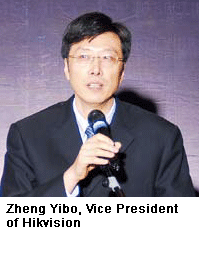While everyone is familiar with Made in China electronic security products, the Chinese security industry is also moving into design in a big way. Today, of the more than 5,000 products that are globally traded, China is exporting more than 2,000. For 200 of these, China is one of the top five producers in the world; for 80 it is No. 1. In Chinaˇs largest export market the U.S. 70 percent of products sold are made in China. Due to favorable trade balances, Chinese foreign exchange reserves soared to US$1.5 trillion by the end of 2007. ASMAG.com talks to Zheng Yibo, Vice President of Hikvision about this important trend.
While everyone is familiar with Made in China electronic security products, the Chinese security industry is also moving into design in a big way. Today, of the more than 5,000 products that are globally traded, China is exporting more than 2,000. For 200 of these, China is one of the top five producers in the world; for 80 it is No. 1. In Chinaˇs largest export market the U.S. 70 percent of products sold are made in China. Due to favorable trade balances, Chinese foreign exchange reserves soared to US$1.5 trillion by the end of 2007. ASMAG.com talks to Zheng Yibo, Vice President of Hikvision about this important trend.
QDiscuss Chinaˇs role in global trade as the worldˇs manufacturing center.
AFirst, increasing foreign investment and commercial expansion are creating the requisite conditions for ongoing development in Chinese manufacturing. Second, China has a large labor supply, which helps keep wages low. Third, China has a large domestic market. Fourth, the nation possesses a large number of qualified engineers, technicians and development specialists. As part of this, the Chinese security industry is maturing, and its share of exports is rising.
QTell us about the shift from Made in China to Designed in China.
AChinese manufacturing is shifting from only manufacturing products to designing them. Production is moving from low-profit, low-value-added items to those with high profits and high added value. In the broader sense, Designed in China encompasses the whole process from R&D to sales and marketing. In a narrower frame, it involves manufacturing design. It should be pointed out though that despite successes, China still has a long way to go in catching up to Japan, Korea and Taiwan.
QHow are Chinese companies honing design capabilities?
ACompanies need to have definite development strategies. They must have integrated strategies that clearly outline part design details in order to effectively allocate resources. Chinese say one should act according to oneˇs capabilities. For businesses, that means knowing how to use their R&D talent, technology, investment funds and marketing campaigns.
Why, for example, did Hikvision enter security? Hikvision used to be a subsidiary  laboratory of China Electronic No. 52 Research Institute; it focused on R&D of IT technology. It had accumulated certain technology in computer PCB production, networking, operating systems, and encoder and decoder cards. We also had a solid foundation. Hikvisionˇs main client then was in the financial sector. It was updating from a simulated monitoring system to a digital supervision one.
laboratory of China Electronic No. 52 Research Institute; it focused on R&D of IT technology. It had accumulated certain technology in computer PCB production, networking, operating systems, and encoder and decoder cards. We also had a solid foundation. Hikvisionˇs main client then was in the financial sector. It was updating from a simulated monitoring system to a digital supervision one.
The reason why I shared this example was to better underline the importance of moving beyond the meager profits of "sweat shops" by engineering technological or product breakthroughs that are characteristic of the "creative industry." Creativity need not involve only core techniques; Designed in China also means changing the business model.
QWhat makes you confident that Chinese industry will succeed in the shift to Designed in China?
AFirst, we have greater flexibility in producing and offering industry support. Second, we have an obvious superiority in terms of human capital. Third, we are more familiar with our own domestic market, and it is huge. Chinese security enterprises start out by meeting domestic demand before venturing overseas. Fourth, Chinese people are well-established all over the world. They provide a good contact window for new markets. Fifth, as enterprises expand, they accumulate technology, funding and distribution channels. Sixth, Chinese manufacturers are clearly moving from copy and mass produce to real design. Seventh, Chinese companies are patenting more and more.
QWhat areas show the greatest potential?
AI think that Chinese companies can design security products and systems very well, including even some software and applications. Foreign software companies, however, have long dominated the Chinese market. I do not underestimate this challenge. It is going to require a lot of hard work; it will take time. Right now, our strengths lie rather in industrial design. While Chinese enterprises do this very well at a basic level, the technology and appearance still require some work. Actually, 70 percent of the quality depends on the design. This has been our experience at Hikvision.
In addition, product concepts need to change. While one design may capture a target market for a period of time, the competition means that you can never rest on your laurels. To retain long-term competitiveness, companies need to build teams, technology platforms and progressive management processes.
QWhat else needs to be done?
AWe also need to address the following points:
* To strengthen national creativity, protect intelligent property rights and fight pirating;
* To develop international best-of-breed business practices;
* To guarantee quality, we need to pay more attention to the costs involved;
* To familiarize ourselves with requirements of international customers to make our products more user-friendly;
* To equip ourselves with overseas marketing expertise;
* To develop design talent, especially those who can communicate well with foreign customers.